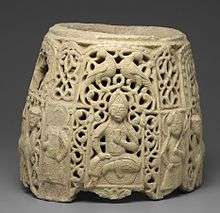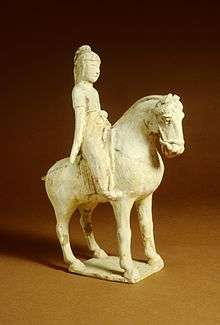Earthenware

Earthenware is glazed or unglazed nonvitreous pottery[1] which has normally been fired below 1200°C.[2] Porcelain, bone china and stoneware, all fired at high enough temperatures to vitrify, are the main other important types of pottery.
Earthenware comprises "all primitive pottery whatever the color, all terra-cottas, most building bricks, nearly all European pottery up to the seventeenth century, most of the wares of Egypt, Persia and the near East; Greek, Roman and Mediterranean, and some of the Chinese; and the fine earthenware which forms the greater part of our tableware today."[3] Pit fired earthenware dates back to as early as 29,000–25,000 BCE.[4][5] Outside East Asia, porcelain was manufactured only from the 18th century, and then initially as an expensive luxury.
Earthenware, when fired, is opaque and non-vitreous,[6] soft and capable of being scratched with a knife.[3] The Combined Nomenclature of the European Communities describes it as being made of selected clays sometimes mixed with feldspars and varying amounts of other minerals and white or light-colored (i.e., slightly greyish, cream or ivory).[6]
Characteristics
Generally, earthenware bodies exhibit higher plasticity than most whiteware[7] bodies and hence are easier to shape by RAM press, roller-head or potter's wheel than bone china or porcelain.[8][9]
Due to its porosity, earthenware, with a water absorption of 5-8%, must be glazed to be watertight.[10] Earthenware has lower mechanical strength than bone china, porcelain or stoneware, and consequently articles are commonly made in thicker cross-section, although they are still more easily chipped.[8]
Darker-colored "terracotta" earthenwares, typically orange or red, due to a comparatively high content of iron oxide are widely used for flower pots, tiles and some decorative and oven wares.[3]
Production
A general body formulation for contemporary earthenware is 25% kaolin, 25% ball clay, 35% quartz and 15% feldspar.[8][11]

Modern earthenware may be biscuit (or "bisque")[12][13] fired to temperatures between 1,000 and 1,150 °C (1,800 and 2,100 °F) and glost-fired[14] (or "glaze-fired")[3][15] to between 950 to 1,050 °C (1,740 to 1,920 °F), the usual practice in factories and some studio potteries. Some studio potters follow the reverse practice, with a low-temperature bisque firing and a high-temperature glost firing. The firing schedule will be determined by the raw materials used and the desired characteristics of the finished ware.
Historically, such high temperatures were unattainable in most cultures and periods until modern times, though Chinese ceramics were far ahead of other cultures in this respect. Earthenware can be produced at firing temperatures as low as 600 °C, and many clays will not fire successfully above about 1000 °C. Much historical pottery was fired somewhere around 800 °C, giving a wide margin of error where there was no precise way of measuring temperature, and very variable conditions within the kiln.
After firing most earthenware bodies will be colored white, buff or red. For red earthenware, the firing temperature affects the color of the clay body. Lower temperatures produce a typical red terracotta color; higher temperatures will make the clay brown or even black. Higher firing temperatures may cause earthenware to bloat.
Types of earthenware

There are several types of earthenware, including:
- Terracotta: a term used for a rather random group of types of objects, rather than being defined by technique
- Tin-glazed pottery, or Faience
- Lead-glazed earthenware
- Lusterware with special iridescent glazes
- Raku
- Ironstone china, on the border of earthenware and stoneware
- Yellowware
References
- ↑ ASTM C242 – 15. Standard Terminology Of Ceramic Whitewares And Related Products
- ↑ Getty AAT, "Earthenware"
- 1 2 3 4 Dora Billington, The Technique of Pottery, London: B.T.Batsford, 1962
- ↑ "Modern Ceramic Engineering: Properties, Processing And Use In Design." D.W. Richerson. CRC Press. 2006.
- ↑ "On the Origins of Pottery." P.M.Rice. Journal of Archaeological Method and Theory. Vol 6, No.1. 1999.
- 1 2 Combined Nomenclature of the European Union Published by the EC Commission in Luxembourg, 1987
- ↑ An industry term for ceramics including tableware and sanitary ware
- 1 2 3 Whitewares: Testing and Quality Control. W.Ryan and C.Radford. Institute of Ceramics & Pergamon. 1987.
- ↑ Pottery Science: Materials, Process And Products. Allen Dinsdale. Ellis Horwood. 1986.
- ↑ Ceramics Glaze Technology. J. R. Taylor & A. C. Bull. Institute of Ceramics & Pergamon Press. 1986
- ↑ Dictionary of Ceramics, 3rd edition. A. E. Dodd & D. Murfin. Maney Publishing. 1994.
- ↑ Rich, Jack C. (1988). The Materials and Methods of Sculpture. Courier Dover Publications. p. 49. ISBN 9780486257426.
- ↑ "Ceramic Arts Daily – Ten Basics of Firing Electric Kilns". ceramicartsdaily.org. 2012. Retrieved 16 April 2012.
- ↑ Norton, F.H. (1960). Ceramics an Illustrated Primer. Hanover House. pp. 74–79.
- ↑ Frank and Janet Hamer, The Potter's Dictionary of Materials and Techniques
- ↑ "Women on Horseback". The Walters Art Museum.
Further reading
- Rado, P. An Introduction to the Technology Of Pottery. 2nd edition. Pergamon Press, 1988.
- Ryan W. and Radford, C. Whitewares: Production, Testing And Quality Control. Pergamon Press, 1987.
- Hamer, Frank and Janet. The Potter's Dictionary of Materials and Techniques. A & C Black Publishers Limited, London, England, Third Edition, 1991. ISBN 0-8122-3112-0.
- "Petersons": Peterson, Susan, Peterson, Jan, The Craft and Art of Clay: A Complete Potter's Handbook, 2003, Laurence King Publishing, ISBN 1856693546, 9781856693547, google books
External links
- Digital Version of "A Representation of the manufacturing of earthenware" — 1827 text on the manufacture of earthenware
- Short film on pottery making around the world
- Tin-glazed earthenware livery-button, ca 1651, Victoria & Albert museum jewellery collection